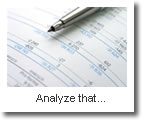White Paper - "Trading Seasonality" - What Is Seasonality?
Introduction
What Is Seasonality?
The Yearly Seasonal Cycle
Seasonality Zonestm
Seasonal Heat
Seasonality And Other Instruments
Deploying Seasonality As Part Of An Overall Strategy
Conclusion
In general, seasonality is some repeatable tendency of a financial instrument to move in relation to a particular influencing factor. That factor could be the time of year, the year of a decade, changes in interest rates, inflation, energy prices, etc. We focus on stock price action and seasonal cycles derived from the time of the calendar year.
Seasonal cycles do not cause prices to move a certain way. They simply reflect a measure of tendency. Ongoing price action is influenced by many factors, only some of which occur on a regular, repeated basis. Those factors that regularly cause a stock price to move a certain way at a particular time of the year may or may not be known, but their seasonal influence will show up in the seasonal indicators and can be qualified by several techniques to measure the breadth and consistency of a stock's seasonal pattern.
When entering into a trade, there are two basic types of indicators: setups and triggers. Seasonality is a setup indicator. Setup indicators are designed as filters that steer the trader to moments when making a trade will result in greater success than others. Examples of setup indicators other than seasonality include sentiment (a contrary setup indicator,) industry group relative performance, fundamental information (e.g. earnings momentum) and price, volume, or other "divergence" oscillators (e.g. Relative Strength Index or "RSI," Moving Average Convergence/Divergence or "MACD," or Erlanger Volume Swing.) Oscillators are used as setups most often when they begin to diverge from price action. For instance, if price is rising to a new reaction high unconfirmed by the RSI oscillator, a setup for a potential short sale exists. Triggers are designed to tell the trader the exact moment to execute a trade by measuring when price begins to move in the direction indicated by setup indicators. Examples of triggers include moving average crossovers, price moving through a DMA (displaced moving average) channel, or a change in status of a trend direction indicator. Some indicators, like the MACD are used as both setup and triggers (setup when the MACD diverges with price, trigger when the MACD crosses its signal line.)
The trading process typically begins with the prelude of one or more signals from setup criteria, and then the trade is made when the market moves sufficiently in the anticipated direction to set off the trigger indicator. After the entry trade, "monitoring" indicators are used to exit the trade. These "monitoring" indicators can in some instances be the same indicators used for set-up or trigger events, or they can be a completely different set of indicators or indicator criteria. For instance, one can trigger a long position if price moves above the 10-day moving average, but "monitor" the position and sell only if price falls below the 21-day average. The indicators and criteria are up to the individual trader's style and preference.
Stock price changes are what the trader tries to exploit. At the end of the day the successful trader either buys at a lower price than sold, or sells short at a higher price than covered (buying to close out a short position.) Setup and trigger indicators therefore generate information for either direction of an opening trade (long or short.) Seasonality uncovers those moments when the market or stock tends to rise (a set up for long trades) or fall (a set up for short trades.) The beauty and marvel of seasonality is that it is known so far in advance, and yet still has value as a timing mechanism. We know of no other stock market factor that has this feature. Let's step through the process of developing seasonal statistics for stocks, and examine how effective they can be for trading purposes.

